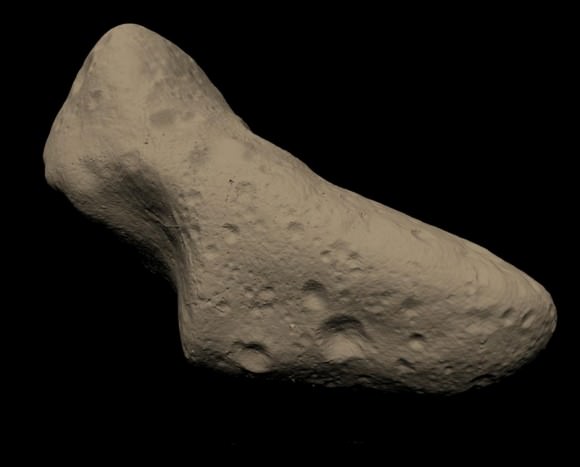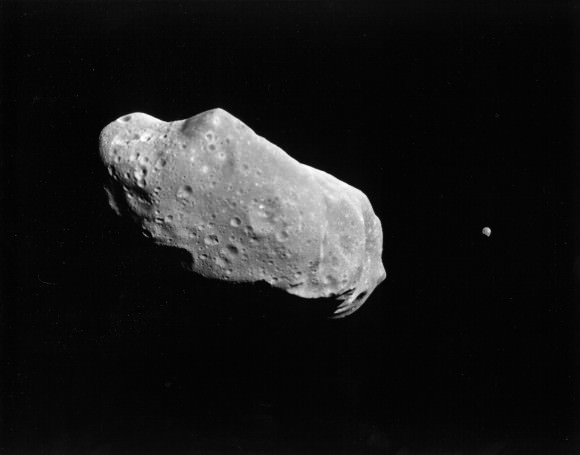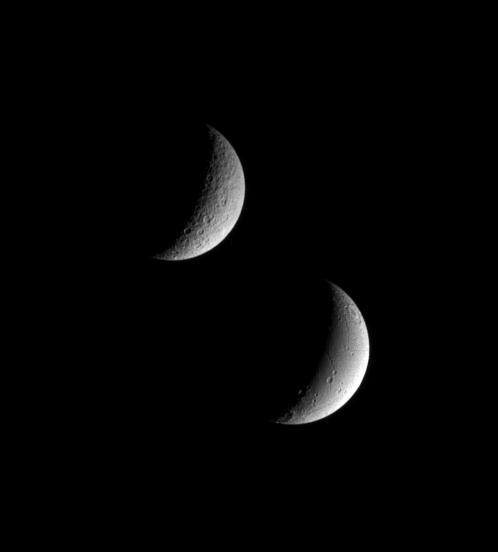[/caption]
In the fall of 2006, observers at the Catalina Sky Survey in Arizona found an object orbiting the Earth. At first, it looked like a spent rocket stage — it had a spectrum similar to the titanium white paint NASA uses on rocket stages that end up in heliocentric orbits. But closer inspection revealed that the object was a natural body. Called 2006 RH120, it was a tiny asteroid measuring just a few metres across but it still qualified as a natural satellite just like the Moon. By June 2007, it was gone. Less than a year after it arrived, it left Earth’s orbit in search of a new cosmic companion.
Now, astrophysicists at Cornell are suggesting that 2006 RH120 wasn’t an anomaly; a second temporary moon is actually the norm for our planet.
Temporary satellites are a result of the gravitational pull of Earth and the Moon. Both bodies pull on one another and also pull on anything else in nearby space. The most common objects that get pulled in by the Earth-Moon system’s gravity are near Earth objects (NEOs) — comets and asteroids are nudged by the outer planets and end up in orbits that bring them into Earth’s neighbourhood.

The team from Cornell, astrophysicists Mikael Granvik, Jeremie Vaubaillon, Robert Jedicke, has modeled the way our Earth-Moon system captures these NEOs to understand how often we have additional moons and how long they stick around.
They found that the Earth-Moon system captures NEOs quite frequently. “At any given time, there should be at least one natural Earth satellite of 1-meter diameter orbiting the Earth,” the team said. These NEOs orbit the Earth for about ten months, enough time to make about three orbits, before leaving.
Luckily, and very interestingly, this discovery has implication well beyond academic applications.
Knowing that these small satellites come and go but that one is always present around the Earth, astronomers can work on detecting them. With more complete information on these bodies, specifically their position around the Earth at a given time, NASA could send a crew out to investigate. A crew wouldn’t be able to land on something a few metres across, but they could certainly study it up close and gather samples.

Proposals for a manned mission to an asteroid have been floating around NASA for years. Now, astronauts won’t have to go all the way out to an asteroid to learn about the Solar System’s early history. NASA can wait for an asteroid to come to us.
If the Cornell team is right and there is no shortage of second satellites around the Earth, the gains from such missions increases. The possible information about the solar system’s formation that we could obtain would be amazing, and amazingly cost-efficient.


Nice article.
“Called 2006 RH120, it was a tiny asteroid measuring just a few metres across but it still qualified as a natural satellite just like out Moon.”
out Moon = our Moon
Actually, since “Moon” is a proper noun, it should be preceded by the definite article “the”, not the pronoun “our”.
Unless it’s being referred to affectionately, that is. I’m afraid I’m going to have to disagree with our Ivan.
Nevertheless, the Moon is an inanimate object and also the only one referred to by that name; therefore, it should be defined by “the” and not “our”. 🙂
Nevertheless, the Moon is an inanimate object and also the only one referred to by that name; therefore, it should be defined by “the” and not “our”. 🙂
Wouldn’t it also be a good idea to mount relative cheap telemetry instrumentation on them while they’re here? Perhaps instruments that could monitor the cosmic-ray intensity, or solar wind speed, or monitor the local Solar magnetic field, or….. I’m not talking a telescope on each, just something simple (and cheap). The problem of getting the data to us is of course a more difficult one. Maybe rig it to be able to get free from the rock again once its power is below a certain level, and program it to orient itself to send its entire x years of observations in one burst once it’s gotten itself pointed at earth again…
We could have a cheap probe of the Heliosphere every 10 months or so, giving us tonnes of data. Come to think of it, if we find one our models predict is going on a particularly interesting trip after its visit, we could put our instrument on a timer so it can use its energy optimally…
Well, it’s settled then 😀 These puppies are the next Pioneer’s!!!! Ok, bye
Why should it run out of energy?
It doesn’t sound like these rocks would get much farther from the sun than we are, so solar panels should provide the telemetry instruments with enough power to radio back to earth for decades.
If there was reason to expect the rock to go very far from the sun, an RTG like the Voyager, Cassini & Curiosity missions are using will keep going for many decades.
Well, the reason I didn’t have my hypothetical telemeters rely on Solar energy, is that they won’t have the luxury of standing still enough. These asteroids rotate about their axes at a variety of different angles and rates, both making it hard to ensure that the Solar panels get enough light. True, in many cases Solar power would be do-able, but invariably it’s going to be a technically challenging thing to make the telemeter reliant on Solar power. The second effect of the rotation would be to make it very hard for the telemeter to actually point a dish in our direction all the time, which is why I had them pop off the rock to pass us their data from space.
Maybe another approach would be to put them on one of the rotational poles of the asteroid….. Anyhow, the guys at NASA are better equipped to judge which approach would work best, as they have the data at hand. Still a fun idea to play with :D. We could even consider putting a man down on one in a modified capsule for a few weeks, just for the heck of it 😛
I must say I don’t really understand why anyone would bother mounting anything on a spacerock unless they intended to study that spacerock. Instruments that monitor anything other than the spacerock itself would work just as well, probably better, if they were mounted not on a spacerock but on an actual spacecraft.
If all the spacerock provides is a platform, then there’s no point – you don’t need platforms in space!
Hmm… I find the first picture to be misleading, as there are no massive wandering objects large enough to be considered a second “moon”. Another thing about “moons” is that they should be called natural satellites, as Moon is reserved as the title of our largest natural satellite.
Actually, “Moon” with a capital “M” is Earth’s moon, while “moon” with a lowercase “m” is any other natural satellite.
An unavoidable result of knowing about the former much sooner than any of the latter. 🙂
Yes, the image would be misleading if it wasn’t appropriately captioned… which it is:
“Saturn’s moons Rhea and Dione as seen by the Cassini spacecraft. Could this be a future view from Earth? Image credit: NASA/JPL/Space Science Institute”
Regardless of the answer to that question, the image choice is valid.
Quite Interesting.
However, while we are on the subject, how about the objects mentioned (& ridiculed) on this very site?
How Many Moons Does Earth Have?
by Fraser Cain on June 12, 2008
How many satellites does Earth have?
With more the 60 moons orbiting Jupiter, and 2 going around Mars, you might think that we should have plenty of moons orbiting Earth. But no, Earth only has one moon… the Moon.
Scientists think that the Moon was formed when a giant Mars-sized object crashed into the Earth, early on in its history. The enormous collision threw up a tremendous amount of debris.
Most of it rained back down on the molten planet, but some of it stayed in orbit, and coalesced into the Moon we know today.
Although there are many different names for the Moon: blue moon, harvest moon, new moon, full moon, it’s all just describing the same object.
There are two other objects that some scientists have referred to as Earth’s other moons, but they aren’t really moons.
The first is called 3753 Cruithne, and it’s not a moon at all, but an asteroid that orbits the Sun.
Since its orbit takes the same amount of time to orbit the Sun as the Earth, it sometimes looks like it’s following Earth in orbit around the Sun. Although the orbit of Cruithne comes very close to Earth, the two objects can never really collide because Cruithne’s orbit is tilted to that of the Earth’s by 19.8°. It’s a very interesting object, and has an orbit that interacts with Earth, 3753 Cruithne really doesn’t quality as a satellite of Earth.
Have you been keeping count? How many moons does Earth have? Still just 1.
The other object is called 2002 AA29, and it takes an even more bizarre orbit around the Sun. It spends most of its time in a horseshoe orbit, oscillating up and down near the Earth. Every 95 years or so, 2002 AA29 comes within 5.9 million km of Earth. Because it’s so close to Earth, scientists have suggested that it might make an ideal target for a space mission to retrieve a sample and bring it back to Earth.
Astronomers thought they might have discovered another moon in 2002, which they designated J002E3. But it turned out to be the third stage of the Apollo 12 Saturn V rocket.
Still keeping count? The Earth has only one moon.
However, while we are on the subject, how about the objects mentioned (& ridiculed) on this very site?
None of the objects mentioned by Fraser are moons. 3753 Cruithne orbits the Sun. 2002 AA29 orbits the Sun. J002E3 isn’t natural.
Fraser mentions no other objects.
However it does seem Fraser was mistaken in insisting Earth has only one moon, seeing as the article was written 2 years after 2006 RH120 – which apparently qualifies as a natural satellite – was detected.
These moons are transients, some 3 orbits at most. While they are more like regular moons they don’t have a regular orbit. (See the figs in the source link.)
So I assume they fare better than the irregulars mentioned above, while they are still not bound moons.
If these puppies are on average ~ 1 m diameter, maybe it is easier to lug some of them home in a Dragon. They would weigh some m = ρ * V ~ 3*10^3 * 4/3*π*(1/2)^3 ~ 12/8 ~ 1.5*10^3 kg, while the down mass capacity of a Dragon is ~ 3*10^3 kg.
Assuming the front hatch can be used, it has a 1.3 m aperture. The payload volume is ~ 10 m^3 which with a ~ 0.5 m^3 load leaves ample room for a crew, the same as for down mass.
Of course, I don’t know if anyone would like to play pin ball with a stone during a 3.5 g descent!
Would it be necessary to capture the entire thing? It would be a far easier task to simply obtain several samples (from various points on the surface and from various depths with careful drilling) – and I imagine the output of scientific knowledge would be the same.
That said, it would be an impressive achievement for space technology and I would support it just on that token alone.
” A crew wouldn’t be able to land on something a few metres across (…).”
That reminded me of what an old book from the late Sixties, HABITABLE PLANETS FOR MAN (S.H. Dole), says about the opposite –taking off from asteroids–, since it points out the maximum size in three cases: a jumping human being, a baseball thrown and a rifle bullet fired.
In the first case, one can leave behind any body having a mass of approx. less than 7 x 10^17 gr. (mean radius: approx. 3.86 km.) supposing one jumps at an initial velocity of 4.87 m/s. Second, one can throw an object like a baseball away from any body with a mass of about less than 2 x 10^20 gr. (m.r.: approx. 25.7 km.), assuming one can throw it at a speed of 33.44 m/s. Third, a rifle bullet can be fired away from any body that has a mass below some 3 x 10^24 gr. (radius: approx. 643.6 km.), assuming a starting velocity of 820 m/s.
This will be important when people finally start to land on asteroids because it leads to the following conclusion and warning: as they explore small space rocks they’ll have to be careful when throwing or firing objects horizontally at speeds that are greater than the circular orbital speed but lower than the escape velocity since they would stay in orbit indefinitely and could be a deadly risk when returning on their nearest approach (periplanet), at which time they would nearly graze the surface.
I guess the NASA won’t need to be reminded, when the time comes, to include that warning during the training of the crew. Someone might idly pick up a stone and throw it in order to see how far it will go, then get hit by the stone in the nape a couple of minutes later, as though a boomerang had been thrown. On the other hand, they might want to hire me just to be sure they won’t overlook something else. Houston would be fine for me since a dear ex-classmate of mine recently moved there, but I won’t complain if it has to be Californee or Floridee.